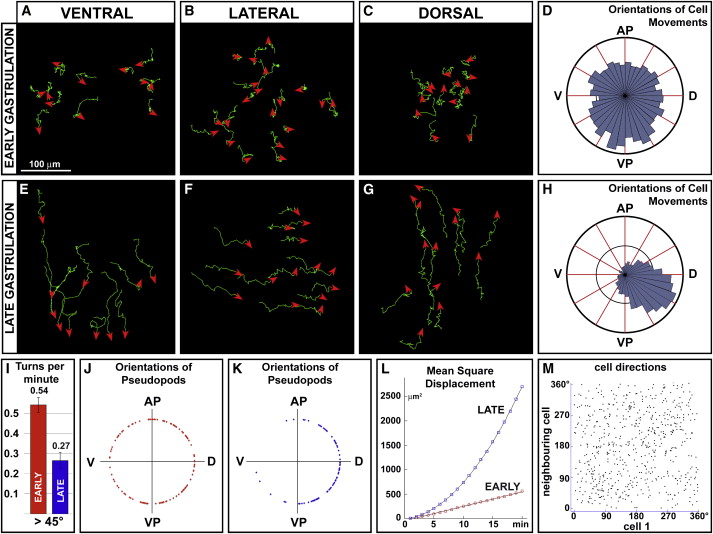Fig. 1 Endodermal Cells Disperse with a Random Walk Movement during Early Gastrulation (A?C and E?G) Representative examples of 30 min tracks with 1 min intervals of endodermal cells in Et(CLG-YFP)smb602 embryos during early (55%?70% epiboly [A?C]) or late (75%?90% epiboly [E?G]) gastrulation (similar tracks were obtained for more than 400 cells on about five embryos per position and stage). During early gastrulation cells move in a nonoriented fashion, whereas during late gastrulation they undergo convergence-extension movements (i.e., dorsal cells migrate anteriorly, lateral cells converge toward the embryonic axis, and ventral cells migrate toward the vegetal pole). Red arrowheads indicate the direction of the last tracked movement. The animal pole is to the top, and for lateral views, dorsal is to the right. (D and H) Rose diagrams representing the directions of endodermal cell movements. During early gastrulation cells migrate in all directions (D) compared to the oriented migration of converging cells during late gastrulation (H). Early gastrulation data were obtained from four time lapses on lateral views (D) and late gastrulation data from four time-lapses on lateral views (H). (I) The graph indicates the average number of turns per minute per cell during early gastrulation (n = 164 cells) or during late gastrulation (n = 68 cells). On average, cells maintained the same direction (angle of turn < 45°) for only 2.21 min compared to 4.95 min for converging cells (p < 0.0001). Error bars represent standard errors. (J and K) Polar plots of the distribution of the outgrowth positions of pseudopods relative to the cell center for lateral cells during early (J) and late (K) gastrulation. Each pseudopod was counted only once, even though pseudopods often persisted for more than one frame. For each diagram, 20 cells from four embryos were analyzed over a 30 min period. (L) Plot (dot and square) and curve fit (line) of the MSD of cells during early (red) and late (blue) gastrulation, showing that whereas converging cells have an oriented migration (parabolic fit, R = 0.999, n = 164 cells), cells move in a random walk during early gastrulation (linear fit, R = 0.998, n = 58 cells). (M) Scatter plot of the direction of a cell and of its closest neighbor, showing that cell movements are not coordinated (R = 0.12, n = 589).
Image
Figure Caption
Acknowledgments
This image is the copyrighted work of the attributed author or publisher, and
ZFIN has permission only to display this image to its users.
Additional permissions should be obtained from the applicable author or publisher of the image.
Full text @ Curr. Biol.

